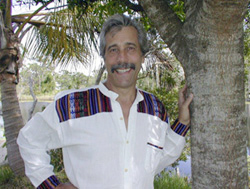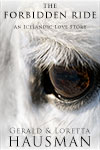

By Gerald Hausman
Bokeelia, FL, USA

Gerald Hausman
Dedicated to the late Mina Yamashita, the artist who created the images that appear with this interview, and to Irene Toya for sharing her extraordinary experience as a deer dancer.
The deer is one of the most sacred of all animals.
To dance the deer dance and sing the deer song is to call forth the blessing of the deer. They are called and brought into the Pueblo and through the dance they become a part of people's lives.
The dance is a prayer for deer, a prayer for all sentient life, a prayer for the bounty of nature. It is thought that when a deer gives its breath – its spirit – to a hunter, then and only then, may the hunter be given its life.
The little deer children in the dance are taken into the homes of the people and given food, warmth and kindness. Later they are released to their rightful parents. This act of charity, of bringing the deer into the home is a ceremony of good spirit. When the hunter brings home the deer, he does so with its permission, asking it to participate in the lives of men.
I asked my friend Irene Toya, a native from San Juan Pueblo on the northern Rio Grande in New Mexico what it was like to be a deer. She had danced the traditional deer dance when she was a child and she told me it was one of the best experiences she could remember. She said that according to ancient memory this ceremonial dance was not done by people. Originally it was done by the deer themselves. But the deer dance like all things that come from long ago is hard to describe. This is how Irene described it to me when I asked her what it was like and what it meant.

Drawing by Irene Toya
IRENE TOYA: My grandmother told me the story of the boy who danced the deer dance so well that at the end of the day he turned into a deer. You know, every year in February when we do the deer dance at the Pueblo we see tracks down along the river. Deer tracks. The old ones say that the spirit of the deer gets into the dancers' hearts, the old and the young dancing together. It is a beautiful thing to see.
GERALD HAUSMAN: How old were you when you did your first deer dance?
IRENE TOYA: I was six years old. I remember how it was. The bonfires up on the mountain just before dawn. I was wearing my deer costume. The horns that tie under the chin and back around the head. White kilt, white shirt. The center of my face was red. White clay from the river went around the red clay in a full circle. There was red clay on my hands and arms too.
GERALD HAUSMAN: Did you like being a deer person?
IRENE TOYA: I was proud to be a young deer waiting for my turn to dance. While we waited we looked up at the bonfires on the mountain. The singers were singing the deer songs. Then just as the sky got pale in the morning light, we saw them. They came out of the blue like a snowy cloud. They were the deer dancers who had been out all night, alone on the mountain.
GERALD HAUSMAN: What did the dancers look like?
IRENE TOYA: They were white and they walked, leaning forward, on their deer sticks. They moved the way deer do. When they came down into the village, all the women threw cornmeal on them. The women prayed and touched them on the shoulder. How beautiful the deer looked in their white sashes, their white shirts and kilts. Their ankle bells ringing in the cold wintry air. The smell of evergreen was in the air too from the branches saved since Christmas. The deer wore the branches on their kilts.

Drawing by Mina Yamashita
GERALD HAUSMAN: How long does the deer dance go on and what age are the dancers?
IRENE TOYA: All day it goes on. I was not the youngest deer that day; there was one three years younger. There were grandmothers and grandfathers in their eighties, and when I looked at them I did not feel too young or too old.
GERALD HAUSMAN: When does the dance end?
IRENE TOYA: Just before sundown. But this is the way it happens. Two dancers come out at this time. They are pretending to be Apaches, as is the old custom. They pretend to shoot the little deer, of which I was one, and then they carry us on their shoulders. One of the Apaches has a big shotgun and when he shoots it, the deer run away. Girls run after them because the deer must be caught before sundown.
GERALD HAUSMAN: What about the little deer?
IRENE TOYA: We are taken away to be "sold off" to the village mothers. It isn't bad really. I was taken by a lady I did not know but when we got to her adobe house it was warm inside. The woodstove was glowing and there was the smell of juniper burning and chili cooking. I was so tired. What I remember was that I sat down and ate and drank. There was chili stew, Indian bread and Coca-Cola. I remember I fell asleep holding an apple.

Drawing by Mina Yamashita
GERALD HAUSMAN: Did you go home then?
IRENE TOYA: My mother was going from house to house looking for me, as is also the custom. I was asleep and dreaming that I was a deer. I was running by the river singing the deer song. The girls were running after me but they could not catch me. I would flick my tail and dance away, and I ran to the top of the mountain. I looked down in the dream at the village. The sun was like a circle of fire around the rim of the mountain. No one could catch me. And then I knew I was the Boy Who Turned Into A Deer.
GERALD HAUSMAN: Is that when you woke up?
IRENE TOYA: Not yet, first I walked away into the darkness to join the other deer down by the river. In my dream I wondered if I would ever see my mother again. My eyes filled with tears and I began bucking and kicking and snorting. Then I woke from that dream and I was in someone's arms – it was my mother who was holding me! I had a big basket in my arms given to me by the lady who had fed me. In the basket were oranges and apples, biscochitos, plums, bread, red chili, posole, pies and cakes.
GERALD HAUSMAN: So you were no longer a little deer...
IRENE TOYA: Still a deer for just a while longer. My uncle took me down to the river and he washed off the red and white clay. After that I was a deer no more, and we went home and the longest and best day of my life was over. But I would always remember what it was like to be free and running up the mountain like the Boy Who Turned Into A Deer.
Illustrations from The Sun Horse: Native Visions of the New World by Gerald Hausman ©1992 All Rights Reserved reproduced with permission from Lotus Press.
Links:
Gerald Hausman's Profile on Stay Thirsty Publishing
Gerald Hausman - Author & Storyteller






